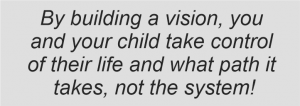Vision Building
but let our dreams determine our needs.”

It impassions us with a sense of unique contribution that’s ours to make.
It empowers us to put first things first, compasses ahead of clocks,
people ahead of schedules and things.”
Keep the focus of your vision on your child’s strengths and interests. Think about the things in life that you value and would like your child to have. Most people value their relationships with others and being an active member of society. We also tend to value being able to pursue things we are good at and using them for something meaningful and purposeful. Usually people are not drawn to do the things they are least skilled at. Similarly, it shouldn’t be expected for our children to have to focus only on their “disability”. Example: If you lack talent in art and you don’t enjoy it, but you are good at math and you enjoy it, you will most likely pursue a life of doing something in math and not art. Sometimes, when a person has a disability, so much focus is on what they can’t do, that they are not given a chance to do the things that they can do or to experience those things that most people value.
Remember with the right supports many things are possible. A desire for a child to have friends, and to work and live in the community can be a dream for every child. That dream is more likely to occur if the child remains in the typical environments as they grow up. That way they will learn to function and interrelate with others using their abilities, and other children will grow up knowing your child and how to relate to them. If you don’t aim for the dream the chances are greater that it won’t be achieved.
Once you’ve made a vision, the next step is to think about what skills and supports might be needed, and how short term goals can lead toward the vision. Let the vision guide everything for your child so that they always remain on a path to their long term goals.
See also:
Suggested related materials
Video : “Miller’s Maps”
There is an excellent video available through the Inclusion Press (You might be able to borrow a copy from different organizations, support groups or technical assistance programs.) In this video, Jack Pearpoint and Marsha Forrest demonstrate how to build a vision or a “map”. MAPS Worksheet
Video: “Employ-ability”
An excellent video produced by Wool Worths that shows people with various types of disabilities working in reputable work establishments. This may help expand the dreams you have for your child and help others overcome stereotypes.
